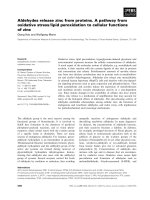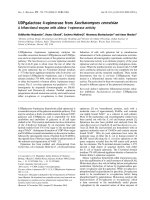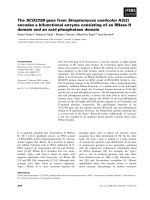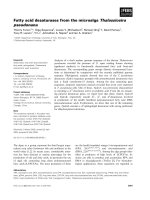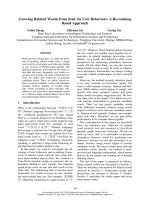Báo cáo khoa học: "Mapping Concrete Entities from PAROLE-SIMPLE-CLIPS to ItalWordNet: Methodology and Results" potx
Bạn đang xem bản rút gọn của tài liệu. Xem và tải ngay bản đầy đủ của tài liệu tại đây (63.45 KB, 4 trang )
Proceedings of the ACL 2007 Demo and Poster Sessions, pages 161–164,
Prague, June 2007.
c
2007 Association for Computational Linguistics
Mapping Concrete Entities from PAROLE-SIMPLE-CLIPS to
ItalWordNet: Methodology and Results
Adriana Roventini, Nilda Ruimy, Rita Marinelli, Marisa Ulivieri, Michele Mammini
Istituto di Linguistica Computazionale – CNR
Via Moruzzi,1 – 56124 – Pisa, Italy
{adriana.roventini,nilda.ruimy,rita.marinelli,
marisa.ulivieri,michele.mammini}@ilc.cnr.it
Abstract
This paper describes a work in progress
aiming at linking the two largest Italian
lexical-semantic databases ItalWordNet and
PAROLE-SIMPLE-CLIPS. The adopted
linking methodology, the software tool
devised and implemented for this purpose
and the results of the first mapping phase
regarding 1
st
OrderEntities are illustrated
here.
1 Introduction
The mapping and the integration of lexical
resources is today a main concern in the world of
computational linguistics. In fact, during the past
years, many linguistic resources were built whose
bulk of linguistic information is often neither easily
accessible nor entirely available, whereas their
visibility and interoperability would be crucial for
HLT applications.
The resources here considered constitute the
largest and extensively encoded Italian lexical
semantic databases. Both were built at the CNR
Institute of Computational Linguistics, in Pisa.
The ItalWordNet lexical database (henceforth
IWN) was first developed in the framework of
EuroWordNet project and then enlarged and
improved in the national project SI-TAL
1
. The
theoretical model underlying this lexicon is based
on the EuroWordNet lexical model (Vossen, 1998)
which is, in its turn, inspired to the Princeton
WordNet (Fellbaum, 1998).
PAROLE-SIMPLE-CLIPS (PSC) is a four-level
lexicon developed over three different projects: the
1
Integrated System for the Automatic Language Treatment.
LE-PAROLE project for the morphological and
syntactic layers, the LE-SIMPLE project for the
semantic model and lexicon and the Italian project
CLIPS
2
for the phonological level and the
extension of the lexical coverage. The theoretical
model underlying this lexicon is based on the
EAGLES recommendations, on the results of the
EWN and ACQUILEX projects and on a revised
version of Pustejovsky’s Generative Lexicon
theory (Pustejovsky 1995).
In spite of the different underlying principles and
peculiarities characterizing the two lexical models,
IWN and PSC lexicons also present many
compatible aspects and the reciprocal
enhancements that the linking of the resources
would entail were illustrated in Roventini et al.,
(2002); Ruimy & Roventini (2005). This has
prompted us to envisage the semi-automatic link of
the two lexical databases, eventually merging the
whole information into a common representation
framework. The first step has been the mapping of
the 1
st
OrderEntities which is described in the
following.
This paper is organized as follows: in section 2
the respective ontologies and their mapping are
briefly illustrated, in section 3 the methodology
followed to link these resources is described; in
section 4 the software tool and its workings are
explained; section 5 reports on the results of the
complete mapping of the 1
st
OrderEntities. Future
work is outlined in the conclusion.
2 Mapping Ontology-based Lexical Resources
In both lexicons, the backbone for lexical
representation is provided by an ontology of
semantic types.
2
Corpora e Lessici dell'Italiano Parlato e Scritto.
161
The IWN Top Ontology (TO) (Roventini et al.,
2003), which slightly differs from the EWN TO
3
,
consists in a hierarchical structure of 65 language-
independent Top Concepts (henceforth TCs)
clustered in three categories distinguishing 1
st
OrderEntities, 2
nd
OrderEntities and 3
rd
Order
Entities. Their subclasses, hierarchically ordered by
means of a subsumption relation, are also
structured in terms of (disjunctive and non-
disjunctive) opposition relations. The IWN
database is organized around the notion of synset,
i.e. a set of synonyms. Each synset is ontologically
classified on the basis of its hyperonym and
connected to other synsets by means of a rich set of
lexical-semantic relations. Synsets are in most
cases cross-classified in terms of multiple, non
disjoint TCs, e.g.: informatica (computer science):
[Agentive, Purpose, Social, Unboundedevent]. The
semantics of a word sense or synset variant is fully
defined by its membership in a synset.
The SIMPLE Ontology (SO)
4
, which consists of
157 language-independent semantic types, is a
multidimensional type system based on
hierarchical and non-hierarchical conceptual
relations. In the type system, multidimensionality is
captured by qualia roles that define the distinctive
properties of semantic types and differentiate their
internal semantic constituency. The SO
distinguishes therefore between simple (one-
dimensional) and unified (multi-dimensional)
semantic types, the latter implementing the
principle of orthogonal inheritance. In the PSC
lexicon, the basic unit is the word sense,
represented by a ‘semantic unit’ (henceforth,
SemU). Each SemU is assigned one single semantic
type (e.g.: informatica: [Domain]), which endows
it with a structured set of semantic information.
A primary phase in the process of mapping two
ontology-based lexical resources clearly consisted
in establishing correspondences between the
conceptual classes of both ontologies, with a view
to further matching their respective instances.
The mapping will only be briefly outlined here
for the 1
st
OrderEntity. More information can be
found in (Ruimy & Roventini 2005; Ruimy, 2006).
The IWN 1
st
OrderEntity class structures
concrete entities (referred to by concrete nouns). Its
main cross-classifying subclasses: Form, Origin,
3
A few changes were in fact necessary to allow the encoding
of new syntactic categories.
4
Composition and Function correspond to the four
Qualia roles the SIMPLE model avails of to
express orthogonal aspects of word meaning. Their
respective subdivisions consist of (mainly) disjoint
classes, e.g. Natural vs. Artifact. To each class
corresponds, in most of the cases, a SIMPLE
semantic type or a type hierarchy subsumed by the
Concrete_entity top type. Some other IWN TCs,
such as Comestible, Liquid, are instead mappable
to SIMPLE distinctive features: e.g. Plus_Edible,
Plus_Liquid, etc.
3 Linking Methodology
Mapping is performed on a semantic type-driven
basis. A semantic type of the SIMPLE ontology is
taken as starting point. Considering the type’s
SemUs along with their PoS and ‘isa’ relation, the
IWN resource is explored in search of linking
candidates with same PoS and whose ontological
classification matches the correspondences established
between the classes of both ontologies.
A characteristic of this linking is that it involves
lexical elements having a different status, i.e.
semantic units and synsets.
During the linking process, two different types
of data are returned from each mapping run:
1) A set of matched pairs of word senses, i.e.
SemUs and synset variants with identical string,
PoS and whose respective ontological classification
perfectly matches. After human validation, these
matched word senses are linked.
2) A set of unmatched word senses, in spite of their
identical string and PoS value. Matching failure is
due to a mismatch of the ontological classification
of word senses existing in both resources. Such
mismatch may be originated by:
a) an incomplete ontological information. As
already explained, IWN synsets are cross-classified
in terms of a combination of TCs; however, cases
of synsets lacking some meaning component are
not rare. The problem of incomplete ontological
classification may often be overcome by relaxing
the mapping constraints; yet, this solution can only
be applied if the existing ontological label is
informative enough. Far more problematic to deal
with are those cases of incomplete or little
informative ontological labels, e.g. 1
st
OrderEntities
as different as medicinale, anello, vetrata
(medicine, ring, picture window) and only
classified as ‘Function’;
162
b) a different ontological information. Besides
mere encoding errors, ontological classification
discrepancy may be imputable to:
i) a different but equally defensible meaning
interpretation (e.g.: ala (aircraft wing) : [Part] vs.
[Artifact Instrument Object]). Word senses falling
into this category are clustered into numerically
significant sets according to their semantic typing
and then studied with a view to establishing further
equivalences between ontological classes or to
identify, in their classification schemes, descriptive
elements lending themselves to be mapped.
ii) a different level of specificity in the
ontological classification, due either to the
lexicographer’s subjectivity or to an objective
difference of granularity of the ontologies.
The problems in ii) may be bypassed by
climbing up the ontological hierarchy, identifying
the parent nodes and allowing them to be taken into
account in the mapping process.
Hyperonyms of matching candidates are taken
into account during the linking process and play a
particularly determinant role in the resolution of
cases whereby matching fails due to a conflict of
ontological classification. It is the case for sets of
word senses displaying a different ontological
classification but sharing the same hyperonym, e.g.
collana, braccialetto (necklace, bracelet) typed as
[Clothing] in PSC and as [Artifact Function] in
IWN but sharing the hyperonym gioiello (jewel).
Hyperonyms are also crucial for polysemous senses
belonging to different semantic types in PSC but
sharing the same ontological classification in IWN,
e.g.: SemU1595viola (violet) [Plant] and
SemU1596viola (violet) [Flower] vs. IWN: viola1
(has_hyperonym pianta1 (plant)) and viola3
(has_hyperonym fiore1 (flower)), both typed as
[Group Plant].
4 The Linking Tool
The LINKPSC_IWN software tool implemented to
map the lexical units of both lexicons works in a
semiautomatic way using the ontological
classifications, the ‘isa’ relations and some
semantic features of the two resources. Since the
157 semantic types of the SO provide a more fine-
grained structure of the lexicon than the 65 top
concepts of the IWN ontology, which reflect only
fundamental distinctions, mapping is PSC Æ IWN
oriented. The mapping process foresees the
following steps:
1) Selection of a PSC semantic type and definition
of the loading criteria, i.e. either all its SemUs or
only those bearing a given information;
2) Selection of one or more mapping constraints on
the basis of the correspondences established
between the conceptual classes of both ontologies,
in order to narrow the automatic mapping;
3) Human validation of the automatic mapping and
storage of the results;
4) If necessary, relaxation/tuning of the mapping
constraints and new processing of the input data.
By human validation of the automatic mapping
we also intend the manual selection of the
semantically relevant word sense pair(s) from the
set of possible matches automatically output for
each SemU. A decision is taken after checking
relevant information sources such as hyperonyms,
SemU/synset glosses and the IWN-ILI link.
Besides the mapping results, a list of unmatched
word senses is provided which contains possible
encoding errors and polysemous senses of the
considered SemUs (e.g., kiwi (fruit) which is
discarded when mapping the ‘Animal’ class). Some
of these word senses proceed from an extension of
meaning, e.g. People-Human: pigmeo, troglodita
(pygmy, troglodyte) or Animal-Human verme,
leone (worm, lion) and are used with different
levels of intentionality: either as a semantic surplus
or as dead metaphors (Marinelli, 2006).
More interestingly, the list of unmatched words
also contains the IWN word senses whose synset’s
ontological classification is incomplete or different
w.r.t. the constraints imposed to the mapping run.
Analyzing these data is therefore crucial to identify
further mapping constraints. A list of PSC lexical
units missing in IWN is also generated, which is
important to appropriately assess the lexical
intersection between the two resources.
5 Results
From a quantitative point of view three main issues
are worth noting (cf. Table 1): first, the
considerable percentage of linked senses with
respect to the linkable ones (i.e. words with
identical string and PoS value); second, the many
163
cases of multiple mappings; third, the extent of
overlapping coverage.
SemUs selected 27768
Linkable senses 15193 54,71%
Linked senses 10988 72,32%
Multiple mappings 1125 10,23%
Unmatched senses 4205 27,67%
Table 1 summarizing data
Multiple mappings depend on the more fine
grained sense distinctions performed in IWN. The
eventual merging of the two resources would make
up for such discrepancy.
During the linking process, many other
possibilities of reciprocal improvement and
enrichment were noticed by analyzing the lists of
unmatched word-senses. All the inconsistencies are
in fact recorded together with their differences in
ontological classification, or in the polysemy
treatment that the mapping evidenced. Some
mapping failures have been observed due to a
different approach to the treatment of polysemy in
the two resources: for example, a single entry in
PSC corresponding to two different IWN entries
encoding very fined-grained nuances of sense, e.g.
galeotto1 (galley rower) and galeotto2 (galley
slave).
Other mapping failures are due to cases of
encoding inconsistency. For example, when a word
sense from a multi-variant synset is linked to a
SemU, all the other variants from the same synset
should map to PSC entries sharing the same semantic
type, yet in some cases it has been observed that
SemUs corresponding to variants of the same synset
do not share a common semantic type.
All these encoding differences or inconsistencies
were usefully put in the foreground by the linking
process and are worthy of further in-depth analysis
with a view to the merging, harmonization and
interoperability of the two lexical resources.
6 Conclusion and Future Work
In this paper the PSC-IWN linking of concrete
entities, the methodology adopted, the tool
implemented to this aim and the results obtained
are described.
On the basis of the encouraging
results illustrated here, the linking process will be
carried on by dealing with 3
rd
Order Entities. Our
attention will then be devoted to 2
nd
OrderEntities
which, so far, have only been object of preliminary
investigations on Speech act (Roventini 2006) and
Feeling verbs. Because of their intrinsic
complexity, the linking of 2
nd
OrderEntities is
expected to be a far more challenging task.
References
James Pustejovsky 1995. The generative lexicon. MIT Press.
Christiane Fellbaum (ed.) 1998. Wordnet: An Electronic
Lexical Database. MIT Press.
Piek Vossen (ed.) 1998. EuroWordNet: A multilingual
database with lexical semantic networks. Kluwer
Academic Publishers.
Adriana Roventini et al. 2003. ItalWordNet: Building a
Large Semantic Database for the Automatic Treatment
of Italian. Computational Linguistics in Pisa, Special
Issue, XVIII-XIX, Pisa-Roma, IEPI. Tomo II, 745 791.
Nilda Ruimy et al. 2003. A computational semantic
lexicon of Italian: SIMPLE. In A. Zampolli, N.
Calzolari, L. Cignoni, (eds.), Computational
Linguistics in Pisa, Special Issue, XVIII-XIX, (2003).
Pisa-Roma, IEPI. Tomo II, 821-864.
Adriana Roventini, Marisa Ulivieri and Nicoletta
Calzolari. 2002 Integrating two semantic lexicons,
SIMPLE and ItalWordNet: what can we gain? LREC
Proceedings, Vol. V, pp. 1473-1477.
Nilda Ruimy and Adriana Roventini. 2005 Towards the
linking of two electronic lexical databases of Italian,
In Zygmunt Veutulani (ed.), L&T'05 -
Nilda Ruimy. 2006. Merging two Ontology-based
Lexical Resources. LREC Proceedings, CD-ROM,
1716-1721.
Adriana Roventini. 2006. Linking Verbal Entries of
Different Lexical Resources. LREC Proceedings, CD-
ROM, 1710-1715.
Rita Marinelli. 2006. Computational Resources and
Electronic Corpora in Metaphors Evaluation. Second
International Conference of the German Cognitive
Linguistics Association, Munich, 5-7 October.
164




